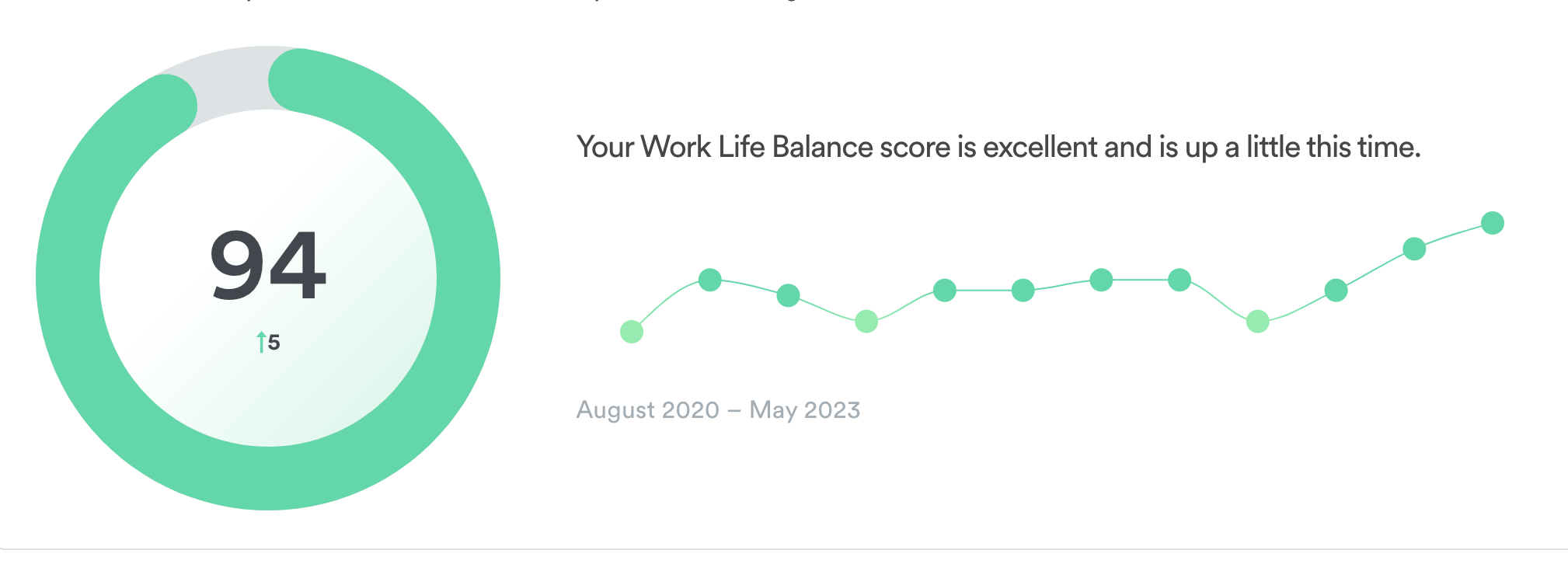Meaning of work life balance
Work life balance definition: Work life balance refers to the harmony between work responsibilities and personal life outside of work. How individuals can effectively manage time, energy, and attention to work related activities while balancing their needs for personal hobbies, family, health and social activities.
Achieving work life balance: A good work life balance requires conscious effort to set healthy boundaries, manage time effectively, practice self-care, prioritize activities and seek help when needed.
Work life balance will look different for each person as each of us has unique preferences, values and circumstances. Finding the right balance is a personal journey that evolves over time and may require adjustments. Not getting it right is a key factor leading to low employee morale.
Importance of work life balance
A poor work life balance is a strong predictor of burn out, as well as long-term loss of productivity and innovation. It is a critical metric for businesses to track and is one of the 15 topics that we measure in our quarterly Culture Profile for clients.
A good work life balance promotes better physical and mental well-being and allows time for employees to take care of their health, stress levels and prevent burn out. In turn they can better deal with work challenges and have a higher quality of life.
Workplaces that promote the importance of a good work life balance benefit from improved productivity and performance as teams are better rested, more focussed and creative. Employees value organizations that support their well-being and offer flexibility to manage personal commitments. This makes it easier to retain top-talent and recruit new team members.
How to improve work life balance
There are many ways organizations can foster a healthy work-life balance. Depending on the size and type of business:
- Offering flexible work arrangements - 4-day work week, or offering flexitime, compressed workweeks or job-sharing.
- Promoting a culture through open communication and promotion of balance at work and home. Encourage holidays and breaks.
- Clearly communicate expectations regarding workload and work hours. Avoid unrealistic demands and set reasonable expectations for employees.
- Offer counseling services to support employees' mental health and well-being, training and development to support time management and stress.
- Create an inclusive and supportive work environment and seek feedback on work-life balance.
1. Consider a 4-day work week
Here at Friday Pulse, our score dropped dramatically from a pre-pandemic
average of 88 to a score of 67, as the outbreak continued. Our score was
high because it’s a topic we take seriously – we encourage employees
only to work 40 hours a week, and to take their holidays. So we decided to do something many still find radical – we switched to a four-day
working week.
We're not alone. Companies like Microsoft in
Japan switched to a four-day schedule and found a 40% increase in productivity and a 23% decrease in electricity use. Even countries like New Zealand and Finland have suggested employers switch to the four-day work week to address persistent work-life balance issues.
There are different ways of approaching a four-day week. While some
firms opt for a compressed schedule that squeezes a 40-hour week into
four days, we adopted a ‘true’ four-day workweek means that
employees’ clock in 32 hours each week. Yes, there is less time to work
with, but the benefits of a four day work week far outweigh this.
More time for you
Time is one of our most valuable commodities. A shorter workweek means
more time. Shorter workdays also reduce the number of sick days taken and having a
three-day weekend every week is essentially an additional 52 days of
time off. So, what kind of effect does all that time have on people?
More focus
With “less” time to get things done, employees are more focused and
companies can reap a bump in productivity right away. Work becomes less of a ‘face
time’ affair and is respectful of people’s time. Meetings are on point.
With extra rest and leisure time, people aren’t limping to the finish
line on a Friday afternoon.
Reducing the carbon footprint
A reduced workweek
also lowers the costs of running the office and commuting - this is also helped by the shift to hybrid working. Without this, overhead costs should go down together with reduced environmental impact. Just the sort of win-win situation our founder and CEO Nic covered in his TED talk 10 years ago.
2. Talk about work life balance
Establish a culture that values work life balance and recognizes its importance in employee well-being and performance. Encourage open communication, lead by example, and promote work life balance as a shared responsibility.
Promote regular breaks and encourage employees to use their entitled vacation time. Discourage a culture of overwork and support employees in taking time off to rest, recharge, and spend quality time with family and friends.
Recognize the challenges faced by employees with caregiving responsibilities, such as parents or caregivers of elderly family members. Offer benefits and support programs that assist employees in balancing their work and caregiving responsibilities, such as flexible hours, parental leave, or access to childcare resources.
3. Establish clear expectations on workload
Avoid unrealistic demands and set reasonable expectations for employees. Encourage effective workload management and provide resources or tools to help employees prioritize tasks and manage their time effectively.
4. Support mental health, well-being and work management skills
Offer employee assistance programs (EAPs) or counseling services to support employees' mental health and well-being. Provide resources and guidance on stress management, work-life balance strategies, and personal development.
Equip employees with the tools and techniques to effectively manage their workloads and achieve a better work-life balance.
5. Develop a supportive environment and get feedback
Create a work environment where employees feel comfortable discussing their work life balance needs. Encourage leaders to have open conversations with employees about their well-being and provide support and resources when needed.
Conduct regular surveys or focus groups to gather employee feedback on work life balance initiatives, policies, and practices. Use the feedback to continuously improve and refine work life balance initiatives within the organization.
Work life balance tips
Work-life balance will look different from person to person. We’ve got a few tips to think about in developing your own healthy balance.
1. Define your work and personal priorities
Clarify your personal and professional priorities to help you make conscious choices about how you allocate your time and energy. Identify what truly matters to you and focus on activities that align with your priorities.
2. Establish boundaries
Set clear boundaries between work and personal life. Determine specific times when you will start and end work, and stick to them as much as possible. Avoid checking work-related emails or messages outside of designated work hours.
3. Prioritize self-care
Make self-care a priority. Take care of your physical, mental, and emotional well-being. Get enough sleep, eat nutritious meals, engage in regular exercise, and allocate time for activities that relax and rejuvenate you.
4. Delegate and ask for support
Recognize that you don't have to do everything alone. Delegate tasks at work and seek support from colleagues or leaders when needed. At home, involve family members or consider outsourcing tasks that can free up your time.
5. Practice effective time management
Manage your time effectively by setting goals, creating to-do lists, and prioritizing tasks. Break down larger tasks into smaller, more manageable steps. Use productivity techniques like the Pomodoro Technique (working in focused bursts with breaks in between) to maximize your efficiency.
6. Unplug
Dedicate specific periods of time each day to disconnect from technology and work-related devices. Use this time to engage in activities that bring you joy, spend quality time with loved ones, or simply relax without distractions.
7. Use holidays
Take advantage of your entitled vacation time and use it to fully disconnect from work. Plan and schedule vacations or staycations in advance to ensure you have dedicated time for relaxation, rejuvenation, and personal activities.
How Friday Pulse can help you achieve work life balance
We had another recent review of the 4 day day workweek and work life balance and had a lot to celebrate. Our most recent scores put us on an astonishing 94 for this metric.
If improving your organization's work life balance is something you’ve considered but you need help, please do contact us. We’d be happy to help you.





